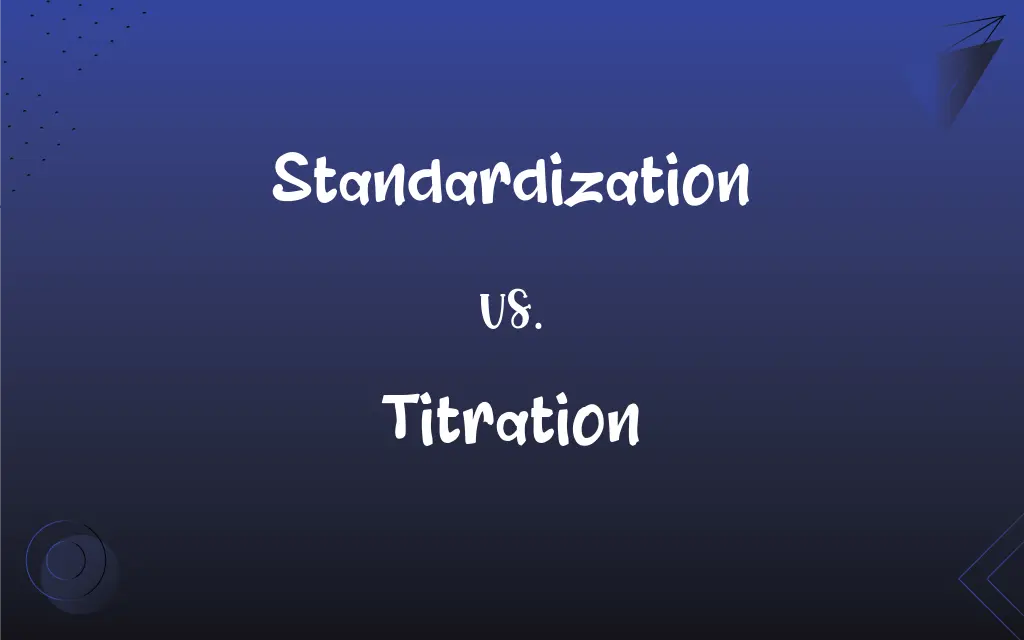Standardization vs. Titration: What's the Difference?
Edited by Aimie Carlson || By Harlon Moss || Updated on October 19, 2023
Standardization is determining the concentration of a solution using a known substance, while titration is the process of adding a solution of known concentration to another solution to determine its concentration.

Key Differences
Standardization is a laboratory procedure wherein the exact concentration of a solution is determined. This process is commonly carried out using a primary standard, a substance of known purity. On the other hand, titration involves gradually adding a solution of known concentration (titrant) to another solution until the reaction between them is complete, often indicated by a color change.
Standardization typically uses a primary standard, which is a highly pure substance. Its concentration is then used as a reference in future experiments. Titration, in contrast, can be used to ascertain the concentration of an unknown solution, using the known concentration of the titrant.
Standardization often precedes titration in many experiments. This is because before a titration can accurately measure the concentration of an unknown solution, the concentration of the titrating solution itself must be known, which is ascertained through standardization.
In the standardization process, the reaction’s end point is usually marked by a clear physical change, such as a color shift. Similarly, in a titration, an indicator or a pH meter is used to signal the end point or equivalence point, where stoichiometrically equivalent amounts of the reactants are combined.
Both standardization and titration are integral procedures in analytical chemistry. Standardization ensures the accuracy of concentrations for reagents used in the lab. Titration, utilizing the known concentrations, can then be employed to determine unknown concentrations in samples.
ADVERTISEMENT
Comparison Chart
Primary Purpose
Determine concentration of a solution.
Determine concentration of unknown solution using a known solution.
Use of Primary Standard
Uses a substance of known purity.
Not always; depends on the standardization.
Sequence in Procedures
Often precedes titration.
Follows after standardization if the titrant's concentration is unknown.
End Point Determination
Requires an indicator or physical change.
Uses an indicator or pH meter.
Application
Ensures accuracy of reagent concentration.
Finds unknown concentrations in samples.
ADVERTISEMENT
Standardization and Titration Definitions
Standardization
Standardization involves using a primary standard of known purity.
They used potassium hydrogen phthalate as a primary standard for the standardization.
Titration
Titration involves adding a known solution to an unknown solution until the reaction completes.
The color change during the titration indicated the reaction's end point.
Standardization
Standardization is essential for the reliability of laboratory procedures.
Without proper standardization, the results could be skewed.
Titration
Titration is a method used to determine the concentration of an unknown solution.
They performed a titration to ascertain the acidity of the vinegar.
Standardization
Standardization sets a benchmark or reference for future measurements.
The standardization process established a reference concentration for the reagent.
Titration
Titration is a staple procedure in analytical chemistry.
During her studies, she mastered various titration techniques.
Standardization
Standardization ensures the consistency and accuracy of measurements.
Standardization of the equipment was crucial for consistent results.
Titration
Titration can ascertain concentrations by reaching an equivalence point.
Through titration, they measured the exact amount of acid in the sample.
Standardization
Standardization is the process of determining the exact concentration of a solution.
Before the experiment, the team conducted a standardization of the sodium hydroxide solution.
Titration
Titration uses indicators to signal reaction completion.
The phenolphthalein used in the titration turned pink, signifying the end.
Standardization
To cause to conform to a standard.
Titration
The process, operation, or method of determining the concentration of a substance in solution by adding to it a standard reagent of known concentration in carefully measured amounts until a reaction of definite and known proportion is completed, usually as shown by a color change or by electrical measurement, and then calculating the unknown concentration.
Titration
(analytical chemistry) The determination of the concentration of some substance in a solution by slowly adding measured amounts of some other substance (normally using a burette) until a reaction is shown to be complete, for instance by the colour change of an indicator.
Titration
The act or process of titrating; a substance obtained by titrating.
Titration
A measured amount of a solution of unknown concentration is added to a known volume of a second solution until the reaction between them is just complete; the concentration of the unknown solution (the titer) can them be calculated
FAQs
What is the main goal of titration?
The main goal of titration is to determine the concentration of an unknown solution using a solution of known concentration.
What is standardization in a laboratory setting?
Standardization is the process of determining the exact concentration of a solution using a substance of known purity.
Is standardization only used in chemistry?
While standardization is integral in chemistry, the concept of ensuring consistency and accuracy can apply in various fields.
What is a primary standard in standardization?
A primary standard is a substance of known purity used in standardization to ascertain the concentration of a solution.
Can titration determine the concentration of gases?
Yes, titration can be used for gases, but the setup and procedure differ from those for liquids.
Can any solution be used for standardization?
For standardization, solutions should be stable, have a known purity, and react completely and specifically.
Are there different types of titration methods?
Yes, including acid-base, redox, and precipitation titrations, each suitable for specific types of reactions.
Why is standardization vital in analytical procedures?
Standardization ensures that the reagents' concentrations are accurate, which is crucial for reliable and reproducible results.
How often should standardization be performed?
Standardization frequency depends on the experiment's precision needs and the stability of the solution.
Is the end point and equivalence point in titration always the same?
Ideally, they should coincide, but sometimes there's a slight difference due to the indicator's behavior.
What role do indicators play in standardization and titration?
Indicators signal the end point of a reaction, often through a visible color change.
What's the relationship between standardization and titration in a typical experiment?
Standardization usually precedes titration to ensure that the titrant's concentration is known accurately for the titration process.
Can titration occur without prior standardization?
It can, but for accurate results, the titrant's concentration should be known, often determined through standardization.
Are there alternatives to titration for concentration determination?
Yes, other methods like spectrophotometry or gravimetry might be used, depending on the sample and required accuracy.
Can standardization and titration errors impact research conclusions?
Absolutely, inaccuracies in these foundational procedures can lead to erroneous conclusions in experiments.
What's an equivalence point in titration?
The equivalence point in titration is when stoichiometrically equivalent amounts of the reactants are combined.
Can titration determine the purity of a substance?
Yes, titration can estimate purity by comparing the expected and observed amounts of titrant used.
How is the end point of a titration determined?
The end point of a titration is typically determined using an indicator that changes color or a pH meter.
Why might standardization results vary between experiments?
Variations can arise from impurities in reagents, environmental conditions, or experimental errors.
How do researchers select a primary standard for standardization?
Selection factors include high purity, stability, and a definite and rapid reaction with the solution being standardized.
About Author
Written by
Harlon MossHarlon is a seasoned quality moderator and accomplished content writer for Difference Wiki. An alumnus of the prestigious University of California, he earned his degree in Computer Science. Leveraging his academic background, Harlon brings a meticulous and informed perspective to his work, ensuring content accuracy and excellence.
Edited by
Aimie CarlsonAimie Carlson, holding a master's degree in English literature, is a fervent English language enthusiast. She lends her writing talents to Difference Wiki, a prominent website that specializes in comparisons, offering readers insightful analyses that both captivate and inform.































































